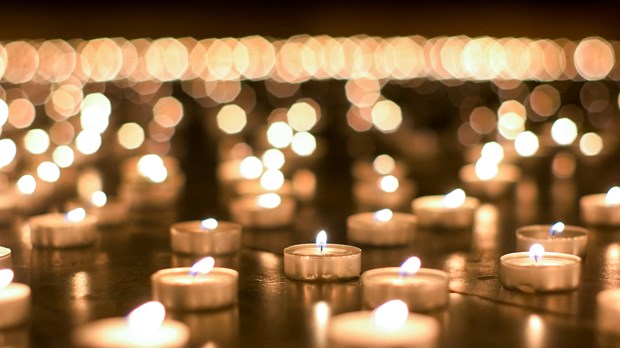Learning to Grieve—Together

Silence hung in the adult Sunday school classroom the week after the Boston Marathon bombing. The death of eight-year-old Martin Richard had dampened the classes' typically dynamic discussion.
"These children were practically babies," one man said, connecting the Boston bombing to the Newtown, Connecticut, shooting the previous year. "How is a parent supposed to go on living after something like this?"
"I know I couldn't get through anything like that without my church," answered the woman sitting across from him. "What do people do without God and faith?"
"God and faith, yes," another gentleman answered. "But, what does the church have to do with it? What does the church, as a community, do for those who grieve?"
Silence hushed the room yet again.
Six years of pastoral ministry have given me a unique perspective on communal Christian grieving. Wakes and funerals offer spaces to cry, moan, and express sadness. Emotional outbursts shock bystanders, but people are quick to allow them and empathize with the one hurting. Folks send food and cards, and visit the family and dear friends of the deceased. Trained lay people such as Stephen Ministers walk alongside the grieving. Pastors refer hurting congregants to counselors and/or group therapy, and check in on them from time to time.
However, most of this care tapers off within one to three months. Beyond the funeral, American Christians don't afford each other space for talking about death and permitting the full rage of grief's emotions. The grieving person is effectively forced to put on a happy face so no one feels uncomfortable.
As the Sunday school class discussed Christianity's relative lack of communal grieving, a man named Doc mused aloud.
"A co-worker of mine is an Orthodox Jew," Doc said. "When his mother died, he was in ritual mourning for her for a year. He wore black, and didn't shave his beard. His congregation supported him with visits and space and time to grieve, as is custom. It seemed like a good thing. We don't have anything like that."
The Jewish community has traditions for mourning that help people grieve well—together. Centuries-old community-centric bereavement rituals usher loved ones through the stages of grief, and they provide the Christian church with a rich theology of communal mourning.
Suffering together: 'sitting shiva'
Jewish families understood the comfort and healing that comes from mourning a loss together. After the burial, the immediate family of the deceased returns to a designated home to "sit shiva." Shiva is derived from the Hebrew word "sheva," which means seven. For seven days the family stays together to grieve. It is a time of intense mourning, says Jewish author Lori Palatnik. Shiva is "an emotionally and spiritually healing time where the mourners sit low and dwell together."
The first three days of shiva are reserved for lamentation. The bereaved stay within their home, and visits are discouraged. Prayers of lament are some of the most powerful in Scripture (see the book of Lamentations and the Psalms of lament, both communal and individual).
The mourner cries out to God in anguish, expelling the agony deep within. She asks the many questions that are upon her heart, holds God accountable for all that is unknown, and, in a sense, lets God "have it." Lament is an act of great faith, as the hurting one stays connected to God in the midst of her misery.
Ideally, the family stays at the shiva house the entire week and does not leave, even for work or school. Friends and loved ones come to comfort them with short visits referred to as 'shiva calls.' Community members provide food and take care of errands for the family, and rabbis are amenable to assist the family with financial needs.
To be seen during the day in public would force [those who grieve] to put on a 'public face,' which is inappropriate during this time. When family, friends and neighbors help out during the week and provide for the needs of the mourners, an atmosphere of love, caring, and kindness is created. This helps to soften the mourner's pain. Again, shiva is a deeply personal time of reflection, coming to terms with loss and grief, and contemplating the inner spiritual dimensions of life. The workplace draws our thoughts and feelings outward, and so should be avoided.
Thirty days of 'shloshim'
The next stage is "shloshim," from the Hebrew word meaning "thirty." This is a 30-day lunar period that includes shiva. Once the mourner leaves the shiva house, some of the restrictions are lifted, and she is able to return to work or school. However, they should severely limit social engagements during this time, and avoid festive outings where music is played. In addition, community members are expected to refrain from inviting grieving people to events. Mourners do not shave or cut their hair during shloshim, as care for one's physical appearance is secondary to grieving well.
With its 30 days, shloshim symbolizes the one who grieves coming full circle. The moon's waxing and waning remind the Jewish faithful that the darkness of grief does not last forever. The waxing light grows ever brighter as each day passes, and a new life without the loved one begins with the new moon.
Those who have lost their parents are in ritual mourning for a one-year period, which includes shiva and shloshim. They are relieved from further restrictions, but are still encouraged to ration social engagements. They are required to wear black, and are still not allowed to shave or cut their hair. The one-year period, among other purposes, allows wounds from loss to heal and prevents the mourner from getting back into life too quickly.
Grieving together with hope
The Jewish stages of mourning are designed to raise the one who grieves "from the abyss of despair to the normalcy of daily life." They allow time, space, and expression of the bereaved's enlongated pain, and understand the role of community in helping heal. The community imitates God in comforting the one who mourns. And God, as Scripture tells us, never abandons God's beloved to mourn in solitude (Isaiah 66:13).
What would it look like if we reshaped the Jewish mourning traditions with Christian theology? When we mourn, how like Jesus would we be to cry out to God in lament: Eli, Eli, lama sabachthani—My God, my God, why have you forsaken me?
The apostle Paul used the human body as metaphor to express the importance of community. In 1 Corinthians 12, he says that each of us is a body part with a unique, divinely given gift, and that the body, or Christian community, needs all of us to live and work together so that it might function according to God's design. When it comes to emotions, Paul again emphasizes community: "If one part suffers, all the parts suffer with it, and if one part is honored, all the parts are glad" (1 Cor 12: 26).
When we share one another's burdens we not only show love our neighbor, we follow the law of Christ (Galatians 6:2).
After Newtown and Boston, how can we, as members of the Christian community, be the hands and feet of Christ to our sisters and brothers in the shiva house? How can we pool our community resources to alleviate financial concerns for those who lost loved ones in the Moore, Oklahoma tornadoes? How can we pray together in such a way that the Holy Spirit's power is palpable for everyone present?
When sitting shiva, might we wonder what it was like for Jesus in the darkness of his tomb? When we leave shiva, shloshim, or complete our year of mourning, what new hope may we find in the resurrection, both Jesus' and the one to come?
"And now, dear brothers and sisters, we want you to know what will happen to the believers who have died so you will not grieve like people who have no hope. For since we believe that Jesus died and was raised to life again, we also believe that when Jesus returns, God will bring back with him the believers who have died" (1 Thessalonians 4: 13-14).
We can grieve well, grieve together, and, thanks be to God, grieve with hope.
Rev. Angie Mabry-Nauta is a writer and an ordained Minister of Word and Sacrament in the Reformed Church in America (RCA). She served as a solo pastor for six years. A regular contributor to Gifted for Leadership, and member of the Redbud Writer's Guild, Angie blogs at "Woman, in Progress…" Follow her on Facebook and Twitter @Godstuffwriter.
Read more articles that highlight writing by Christian women at ChristianityToday.com/Women
 Read These Next
Read These Next

 Easter's FinestWhen Jesus hijacks your holiday
Easter's FinestWhen Jesus hijacks your holiday
 You Are Worth Fighting ForFor when you feel too fat, too frumpy, too stupid, or too poor
You Are Worth Fighting ForFor when you feel too fat, too frumpy, too stupid, or too poor








 Homepage
Homepage